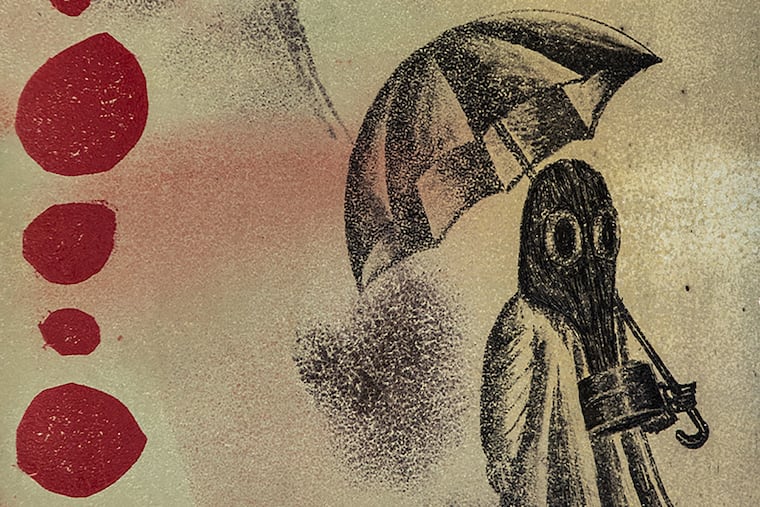Three years ago, this artist couldn’t stop drawing a dystopian image. Now it’s prescient | Helen Ubiñas
“My art's concept is exactly about what we are living," says artist Andrew Lawson.

I had no intention of buying anything at the Rittenhouse Square Fine Art Show last spring.
But it was a nice day to be out — remember those days? — and take in the world around me.
And that’s when I saw it: a hauntingly playful print of a little girl in a flouncy dress holding an umbrella.
I got closer and saw she was wearing a gas mask, her feet seemingly hovering above the ground.
I was immediately drawn to her. Ordinarily, I prefer art by people I know or places that mean something to me, and that, these days, I’m wondering if I’ll ever get to see again.
But this one, I had to have. And now, one year later, I can't stop looking at it.
Suddenly, “Umbrella Girl” seems prescient.
I dug through a box looking for the artist’s card, realizing only later that his contact information was on the back of the framed print that hangs in my dining room.
I emailed with no expectation of a response. I just wanted him to know that something he created had taken on more meaning in these darker days.
I wondered if he saw it, too.
“Yes,” he emailed back. “My art's concept is exactly about what we are living.”
Like many of us, Andrew Lawson was just starting to navigate the full impact of the coronavirus when we talked a couple of weeks ago. He had his water, his toilet paper. But I don’t think either of us had a clue how surreal our world was about to get.
The 34-year-old from Midland, Texas, is a master of fine arts student at Texas Tech University studying printmaking.
Lawson first created “Umbrella Girl” three years ago, but kept returning to her, attracted in part to the power of repeatable images.
His art professors advised him to use other imagery, saying the little girl with the gas mask was overused.
Lawson couldn’t stop, though.
“My goal was to have prints of this little girl in a gas mask everywhere, so people start noticing it, asking questions, and recognizing my work, which then gives me a platform to spread my art and concepts to more and more people,” he said.
He defended his instructors. They are supposed to push students in new directions and mediums, he said. But given how relevant his protagonist now seemed, I dare call him vindicated.
“It just makes me not feel crazy,” he confided.
I made a confession of my own: My working-class upbringing told me I had no business buying art like some fancy. I walked away from the print a few times that day only to find myself back at his tent.
Lawson told me that he usually depicts “Umbrella Girl” under blue skies to highlight the stark contrast of dual realities.
“The juxtaposition between her and her environment helps create the questions: What is she protecting herself from? Dangers from the outside? Or inside?”
Umbrella Girl: part prepper, part participant.
The piece I bought, with a more grim background, was a little different.
I tell people all the time that I run dark — less idealist, more realist. Apparently, that also applies to my taste in fine art.
We talked about his intentions when he created her, the message he wanted to get across — “dystopian and post-humanism outcomes from not just a consumer-based capitalist society but a globalized one as well.”
We are seeing that at play now. As a piece in Politico recently put it: “A global, novel virus that keeps us contained in our homes — maybe for months — is already reorienting our relationship to government, to the outside world, even to one another.”
Society’s sins laid bare.
But, Lawson said, the final interpretation is up to the viewer.
My read of his print changes day by day, sometimes moment to moment, depending on the level of dread from the day’s news cycle.
Some days I look at her, walking alone and in her mask, and fear it is a horrifying peek into our post-pandemic future.
Other days, admittedly desperate for some silver lining, I see something else:
The world in the print is bleak, the image of a little girl in a gas mask alarming.
But there she is, out in the world.
Even in that uncertainty, there is hope.